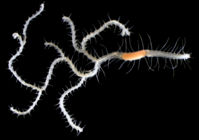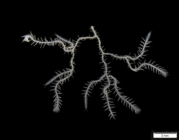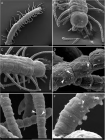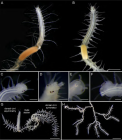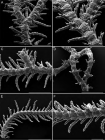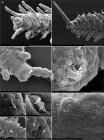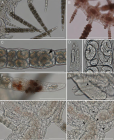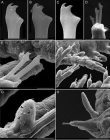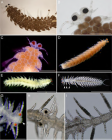WoRMS taxon details
Ramisyllis kingghidorahi Aguado, Ponz-Segrelles, Glasby, Ribeiro, Jimi & Miura, In Aguado, Ponz-Segrelles, Glasby, Ribeiro, Nakamura, Oguchi, Omori, Kohtsuka, Fischer, Ise, Jimi & Miura, 2022
1559001 (urn:lsid:marinespecies.org:taxname:1559001)
accepted
Species
marine, brackish, fresh, terrestrial
recent only
Aguado, M. T.; Ponz-Segrelles, G.; Glasby, C. J.; Ribeiro, R. P.; Nakamura, M.; Oguchi, K.; Omori, A.; Kohtsuka, H.; Fischer, C.; Ise, Y.; Jimi, N.; Miura, T. (2022). Ramisyllis kingghidorahi n. sp., a new branching annelid from Japan. <em>Organisms Diversity & Evolution.</em> 22(2): 377-405., available online at https://link.springer.com/article/10.1007%2Fs13127-021-00538-4
page(s): 13 of 29, figures 5-14; note: In Petrosia sponges, Sado Island, Japan, around 15 m deep [details]
page(s): 13 of 29, figures 5-14; note: In Petrosia sponges, Sado Island, Japan, around 15 m deep [details]
Holotype ZIUG ZMUG 29,568, MNCNM 16.01/19089–90,...
, Note Sado Island, Sea of Japan, Japan, around 15 m...
Holotype ZIUG ZMUG 29,568, MNCNM 16.01/19089–90, geounit Sea of Japan [details]
From editor or global species database
Type locality Sado Island, Sea of Japan, Japan, around 15 m deep, 37.8048 N, 138.2403 E, (37°48′17.1″N, 138°14′25.1″E), in Petrosia sponges [details]
Etymology authors: Ramisyllis kingghidorahi "name refers to King Ghidorah, the three-headed and two-tailed monster enemy of Godzilla....
Etymology authors: Ramisyllis kingghidorahi "name refers to King Ghidorah, the three-headed and two-tailed monster enemy of Godzilla. Both characters were created by Tomoyuki Tanaka based on Japanese mythology and folklore. King Ghidorah is a branching fictitious animal that can regenerate its lost ends. King Ghidorah is assumed to be a male and latinized accordingly" [details]
Read, G.; Fauchald, K. (Ed.) (2024). World Polychaeta Database. Ramisyllis kingghidorahi Aguado, Ponz-Segrelles, Glasby, Ribeiro, Jimi & Miura, In Aguado, Ponz-Segrelles, Glasby, Ribeiro, Nakamura, Oguchi, Omori, Kohtsuka, Fischer, Ise, Jimi & Miura, 2022. Accessed through: World Register of Marine Species at: https://www.marinespecies.org/aphia.php?p=taxdetails&id=1559001 on 2024-07-22
![]() The webpage text is licensed under a Creative Commons Attribution 4.0 License
The webpage text is licensed under a Creative Commons Attribution 4.0 License
original description
Aguado, M. T.; Ponz-Segrelles, G.; Glasby, C. J.; Ribeiro, R. P.; Nakamura, M.; Oguchi, K.; Omori, A.; Kohtsuka, H.; Fischer, C.; Ise, Y.; Jimi, N.; Miura, T. (2022). Ramisyllis kingghidorahi n. sp., a new branching annelid from Japan. <em>Organisms Diversity & Evolution.</em> 22(2): 377-405., available online at https://link.springer.com/article/10.1007%2Fs13127-021-00538-4
page(s): 13 of 29, figures 5-14; note: In Petrosia sponges, Sado Island, Japan, around 15 m deep [details]
page(s): 13 of 29, figures 5-14; note: In Petrosia sponges, Sado Island, Japan, around 15 m deep [details]
 Present
Present  Present in aphia/obis/gbif/idigbio
Present in aphia/obis/gbif/idigbio  Inaccurate
Inaccurate  Introduced: alien
Introduced: alien  Containing type locality
Containing type locality
Holotype ZIUG ZMUG 29,568, MNCNM 16.01/19089–90, geounit Sea of Japan [details]
From editor or global species database
Authority The new species heading limits the species authorities to Aguado, Ponz-Segrelles,Glasby, Ribeiro, Jimi & Miura, but this is not explained [details]
Etymology authors: Ramisyllis kingghidorahi "name refers to King Ghidorah, the three-headed and two-tailed monster enemy of Godzilla. Both characters were created by Tomoyuki Tanaka based on Japanese mythology and folklore. King Ghidorah is a branching fictitious animal that can regenerate its lost ends. King Ghidorah is assumed to be a male and latinized accordingly" [details]
Habitat Always in Petrosia sp. sponges. Authors: "The sponges measured 5–10 cm in diameter and were usually irregularly round and pink, with mostly smooth surfaces except some areas showing crests, dead and healed areas and some large oscula. Immediately after placing the sponges in trays, many very active, fast-swimming male left them. After 2–3 h, swimming female stolons also left, moving slower than males." [details]
Type locality Sado Island, Sea of Japan, Japan, around 15 m deep, 37.8048 N, 138.2403 E, (37°48′17.1″N, 138°14′25.1″E), in Petrosia sponges [details]
